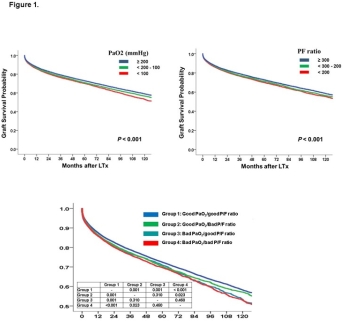Clinical Impacts of Deceased Donor Oxygenation Status in Liver Transplant
T. Okamoto,2 K. Sasaki,3 H. Niikawa,2 M. Fujiki,3 C. Quintini,3 K. Hashimoto,3 C. Miller,3 K. Abu-Elmagd,1 K. McCurry,2 J. Fung.4
1Transplant Center, Cleveland Clinic, Cleveland
2Thoracic and Cardiovascular Surgery, Cleveland Clinic, Cleveland
3Liver Transplantation, Cleveland Clinic, Cleveland
4Transplantation, University of Chicago, Chicago.
Meeting: 2018 American Transplant Congress
Abstract number: D22
Keywords: Donors, Liver transplantation, unrelated
Session Information
Session Name: Poster Session D: Donor Management: All Organs Excluding Kidney
Session Type: Poster Session
Date: Tuesday, June 5, 2018
Session Time: 6:00pm-7:00pm
 Presentation Time: 6:00pm-7:00pm
Presentation Time: 6:00pm-7:00pm
Location: Hall 4EF
Background: PaO2/FiO2 (P/F) ratio of > 300 mmHg in donors is a criterion of standard lung donors, while several studies demonstrated that the utilization of lung donors with P/F ratio of < 300 mmHg was not associated with increased mortality. Conversely, in liver transplant, biliary ischemia in DCD causes postoperative graft dysfunction, suggesting that hypoxemia might contribute to poor graft function. However, the clinical implication of donor P/F ratio in liver transplant has been unclear. This study aimed to elucidate characteristics and prognostic influences of donor PaO2 and low P/F ratio in liver transplant.
Methods: This study used 60,457 adult liver transplant in the scientific registry of transplant recipients (SRTR) from 1998-2015. The degree of association between non-parametric variables was determined using Pearson's correlation coefficient. Differences between continuous values were assessed with the he Kruskal-Wallis test. The Kaplan-Meier method were used to assess prognostic outcomes. P<0.05 was defined as statistical significant.
Results: The median PaO2 was 182 mmHg and low PaO2 defined as PaO2 < 100 mmHg was seen in 4,588 cases. The median P/F ratio was 310 and poor lung function defined as P/F ratio < 200 was seen 15,203 cases. Donor oxygenation levels were significantly correlated to cause of death and numbers of organ recovered (all P < 0.001). The graft survival curves were significantly stratified according to PaO2 and P/F ratio levels (P < 0.001, respectively) [Figure 1]. When the whole cohort was stratified by 4 groups according to good/poor PaO2 and good/poor P/F ratio, good PaO2 improved long-term graft survival (P < 0.05).
Conclusion: Donor oxygenation status was significantly correlated to long-term liver graft survival. Especially maintaining PaO2 of > 100 mmHg improve long-term graft survival even in poor P/F ratio patients.
CITATION INFORMATION: Okamoto T., Sasaki K., Niikawa H., Fujiki M., Quintini C., Hashimoto K., Miller C., Abu-Elmagd K., McCurry K., Fung J. Clinical Impacts of Deceased Donor Oxygenation Status in Liver Transplant Am J Transplant. 2017;17 (suppl 3).
To cite this abstract in AMA style:
Okamoto T, Sasaki K, Niikawa H, Fujiki M, Quintini C, Hashimoto K, Miller C, Abu-Elmagd K, McCurry K, Fung J. Clinical Impacts of Deceased Donor Oxygenation Status in Liver Transplant [abstract]. https://atcmeetingabstracts.com/abstract/clinical-impacts-of-deceased-donor-oxygenation-status-in-liver-transplant/. Accessed December 17, 2025.« Back to 2018 American Transplant Congress
